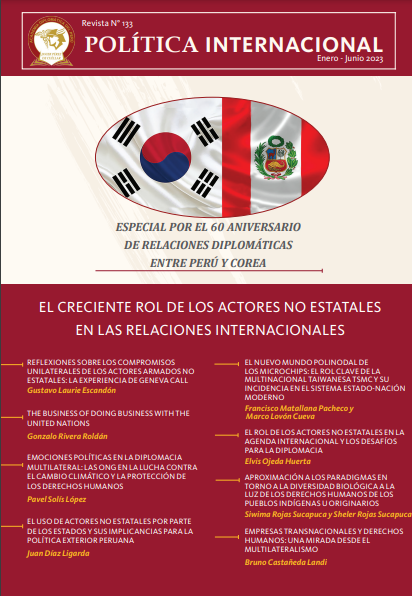Reflexiones sobre los compromisos unilaterales de los actores armados no estatales: la experiencia de Geneva Call
DOI:
https://doi.org/10.61249/pi.vi133.60Palabras clave:
acta de compromiso, actores armados no estatales, conflictos armados, derecho consuetudinario, derecho internacional humanitario, derechos humanosResumen
En la actualidad los actores armados no estatales (AANE) frecuentemente son partes en los conflictos armados, en particular en aquellos de naturaleza no internacional. Estos actores pueden o no ser sujetos del derecho internacional y no son considerados, en principio, como entidades creadoras de normas del derecho internacional humanitario (DIH), aun cuando están obligados a conducirse de conformidad con esta rama del derecho durante los conflictos armados. Sin embargo, su conducta durante estos conflictos puede tener un impacto considerable en la formación, consolidación y respeto de las normas del DIH, así como en el proceso de universalización de las normas convencionales del DIH y su posible materialización en normas consuetudinarias. La celebración de compromisos formales por parte de los AANE puede contribuir en estos procesos, como es el caso de las Actas de Compromiso que, promovidas por la organización no gubernamental Geneva Call, suscriben algunos AANE en respeto de las normas del DIH o de los derechos humanos. Este artículo pretende generar reflexión sobre el impacto jurídico, político y/o humanitario de esta modalidad de compromisos unilaterales.
Descargas
Bibliografía
Clapham, A. (2006). Human Rights Obligations of Non-State Actors, Oxford University Press.
Comité Internacional de la Cruz Roja (s.f.). Convención para la protección de los bienes culturales en caso de conflicto armado (H.CP). https://www.icrc.org/es/doc/resources/documents/misc/treaty-1954-hague-convention-cultural-property5tdm2q.htm
Comité Internacional de la Cruz Roja (s.f.). Convención sobre la prohibición del desarrollo, la producción y el almacenamiento de armas bacteriológicas (biológicas) y toxínicas y sobre su destrucción. https://www.icrc.org/es/doc/resources/documents/misc/treaty-1972-bacteriologicalweapons-convention-5tdm6y.htm
Comité Internacional de la Cruz Roja (s.f.). Convención sobre Prohibiciones o Restricciones del Empleo de Ciertas Armas Convencionales que puedan considerarse excesivamente nocivas o de efectos indiscriminados (CCW). https://www.icrc.org/es/doc/resources/documents/treaty/treaty1980-ccw.htm
Comité Internacional de la Cruz Roja (s.f.). Protocolo sobre Prohibiciones o Restricciones del Empleo de Minas, Armas Trampa y Otros Artefactos (Protocolo II CCW.P.II). https://www.icrc.org/es/doc/resources/documents/treaty/treaty-1980-ccw-protocol-2.htm
Comité Internacional de la Cruz Roja (s.f.). Convención sobre la prohibición del desarrollo, la producción, el almacenamiento y el empleo de
armas químicas y sobre su destrucción. https://www.icrc.org/es/doc/resources/documents/misc/treaty-1993-chemical-weaponsconvention-annex-5tdmj2.htm
Comité Internacional de la Cruz Roja (s.f.). Protocolo sobre Prohibiciones o Restricciones del Empleo de Minas, Armas Trampa y Otros Artefactos según fue enmendado el 3 de mayo de 1996 (Protocolo II según fue enmendado el 3 de mayo de 1996). https://www.icrc.org/es/doc/resources/documents/misc/treaty-1980-cccw-protocol-2-amended1996-5tdl6g.htm
Comité Internacional de la Cruz Roja (s.f.). Convención sobre la prohibición del empleo, almacenamiento, producción y transferencia de minas antipersonal y sobre su destrucción. https://www.icrc.org/es/doc/resources/documents/treaty/treaty-1997-anti-personnel-mines.htm
Comité Internacional de la Cruz Roja (s.f.). Estatuto de Roma de la Corte Penal Internacional. https://www.icrc.org/es/doc/resources/documents/misc/treaty-1998-icc-5tdm58.htm
Comité Internacional de la Cruz Roja (s.f.). Segundo Protocolo de la Convención de La Haya de 1954 para la Protección de los Bienes Culturales en caso de Conflicto Armado. https://www.icrc.org/es/doc/resources/documents/misc/treaty-1954-hague-convention-protocol-2-1999-5tdks5.htm
Comité Internacional de la Cruz Roja (s.f.). Enmienda de 2001 a la Convención de 1980. https://www.icrc.org/es/doc/resources/documents/article/other/treaty-1980-cccw-amendment-article-1-2001-5x6mhx.htm
Comité Internacional de la Cruz Roja (s.f.). Protocolo sobre los Restos Explosivos de Guerra (Protocolo V CCW.P.V). https://www.icrc.org/es/doc/resources/documents/misc/treaty-1980-cccw-protocol-5-erw-5x6lck.htm
Comité Internacional de la Cruz Roja (s.f.). Convención sobre municiones en racimo. https://www.icrc.org/es/doc/resources/documents/publication/p0961.htm
Comité Internacional de la Cruz Roja (1986). Los Convenios de Ginebra del 12 de Agosto de 1949, CICR.
Comité Internacional de la Cruz Roja (1996). Protocolos Adicionales a los Convenios de Ginebra del 12 de Agosto de 1949, CICR.
Comité Internacional de la Cruz Roja (2019). International Review of the Red Cross, Humanitarian debate: Law, policy, action – Memory and War (Vol 101, Número 910), CICR y Cambridge University Press.
Haug, H. (1993). International Humanitarian Law – An Introduction. Henry Dunant Institute HAUPT.
Henckaerts, J.M. y Doswald Beck, L. (2005). Customary International Humanitarian Law, (Vol I: Rules). Comité Internacional de la Cruz Roja, Cambridge University Press.
La Haye, E. (2008). War Crimes in Internal Armed Conflicts. Cambridge Studies in International and Comparative Law, Cambridge University Press.
Mansson, K. (2013). The principle of humanity in the development of “special protection” for children in armed conflict: 60 years beyond the Geneva Convention on the Rights of the Child en Kjetil Mujezinovic Larsen, Camilla Guldahl Cooper y Gro Nystuen (Ed.), Searching for a 'Principle of Humanity' in International Humanitarian Law. Cambridge University Press.
Mc Goldrick, C. (2015). The state of conflict today: Can humanitarian action adapt en International Review of the Red Cross – Humanitarian debate: Law, policy, action: The evolution of warfare, (Vol 97, November, 1179-1208). CICR.
Mc Hugh, G. y Bessler, M. (2006). Humanitarian Negotiations with Armed Groups – A Manual for Practitioners, United Nations.
Minear, L. (2007). The craft of humanitarian diplomacy en Larry Minear y Hazel Smith (Ed.), Humanitarian Diplomacy – Practitioners and Their Craft. United Nations University Press.
Descargas
Publicado
Cómo citar
Número
Sección
Licencia
Derechos de autor 2023 Gustavo Laurie Escandón

Esta obra está bajo una licencia internacional Creative Commons Atribución 4.0.








